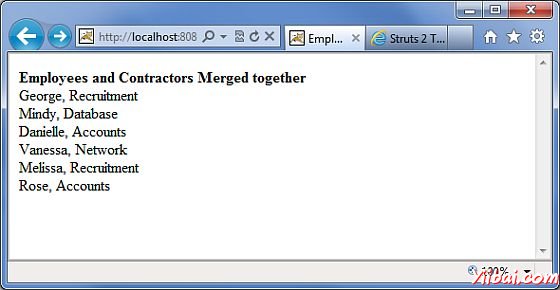Struts2 merge標籤
如果有兩個列表A和B的值,A1,A2和B1,B2。合併列表,會給出A1,B1,A2,B2。
創建動作類:
首先,讓我們創建一個簡單的類叫做Employee.java,它看起來像:
package com.yiibai.struts2; import java.util.ArrayList; import java.util.List; import org.apache.struts2.util.SubsetIteratorFilter.Decider; public class Employee { private String name; private String department; public Employee(){} public Employee(String name,String department) { this.name = name; this.department = department; } private List employees; private List contractors; public String execute() { employees = new ArrayList(); employees.add(new Employee("George","Recruitment")); employees.add(new Employee("Danielle","Accounts")); employees.add(new Employee("Melissa","Recruitment")); employees.add(new Employee("Rose","Accounts")); contractors = new ArrayList(); contractors.add(new Employee("Mindy","Database")); contractors.add(new Employee("Vanessa","Network")); return "success"; } public Decider getRecruitmentDecider() { return new Decider() { public boolean decide(Object element) throws Exception { Employee employee = (Employee)element; return employee.getDepartment().equals("Recruitment"); } }; } public String getName() { return name; } public void setName(String name) { this.name = name; } public String getDepartment() { return department; } public void setDepartment(String department) { this.department = department; } public List getEmployees() { return employees; } public void setEmployees(List employees) { this.employees = employees; } public List getContractors() { return contractors; } public void setContractors(List contractors) { this.contractors = contractors; } }
Employee類有兩個屬性 - name 和 department,我們也有兩個員工名單 - employees 和contractors。我們有一個方法叫做getRecruitmentDecider,返回Decider 對象。Decider 實現返回true,如果僱員招聘部門工作,否則返回false。
接下來,讓我們創建一個DepartmentComparator 比較Employee對象:
package com.yiibai.struts2; import java.util.Comparator; public class DepartmentComparator implements Comparator { public int compare(Employee e1, Employee e2) { return e1.getDepartment().compareTo(e2.getDepartment()); } @Override public int compare(Object arg0, Object arg1) { return 0; } }
在上面的例子所示,部門比較的基礎上按字母順序排列的部門員工進行比較。
創建視圖
創建一個文件叫做employee.jsp以下內容:
<%@ page contentType="text/html; charset=UTF-8"%> <%@ taglib prefix="s" uri="/struts-tags"%>
<s:merge id="allemployees"> <s:param value="employees" /> <s:param value="contractors" /> <s:iterator value="allemployees"> <s:property value="name"/>, <s:property value="department"/>
合併標記需要兩個或兩個以上的列表作爲參數。我們需要給合併一個id,這樣我們就可以重用它。在這個例子中,我們提供了作爲參數傳遞給員工和承包商的合併標籤。然後,我們使用「allemployees」ID合併列表遍歷並打印員工的細節。
配置文件
struts.xml中應該像這樣:
web.xml中,應該像這樣:
<web-app xmlns:xsi="http://www.w3.org/2001/XMLSchema-instance" xmlns="http://java.sun.com/xml/ns/javaee" xmlns:web="http://java.sun.com/xml/ns/javaee/web-app\_2\_5.xsd" xsi:schemaLocation="http://java.sun.com/xml/ns/javaee
http://java.sun.com/xml/ns/javaee/web-app\_3\_0.xsd" id="WebApp_ID" version="3.0">
右鍵點擊項目名稱,並單擊 Export > WAR File創建一個WAR文件。然後部署此WAR在Tomcat的webapps目錄下。最後,啓動Tomcat服務器和嘗試訪問URL http://localhost:8080/HelloWorldStruts2/employee.action。這會給出以下畫面:
